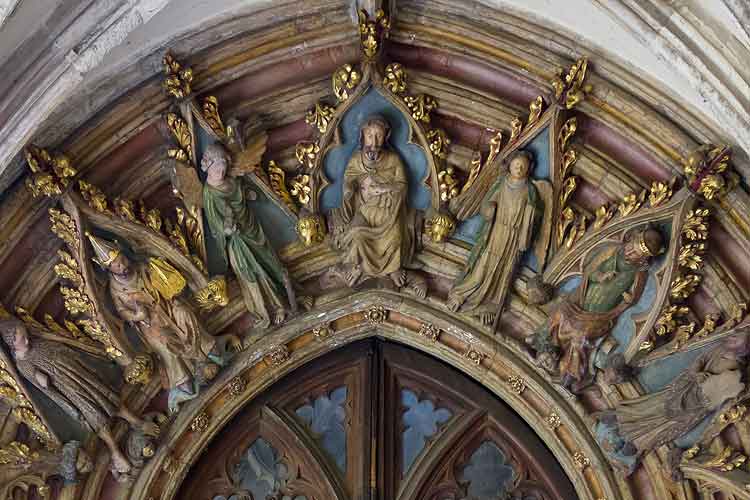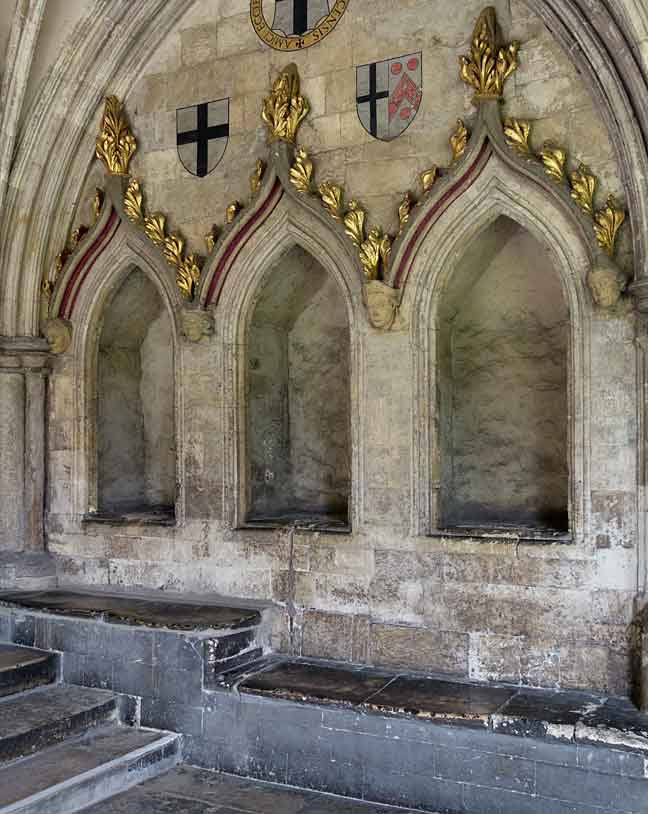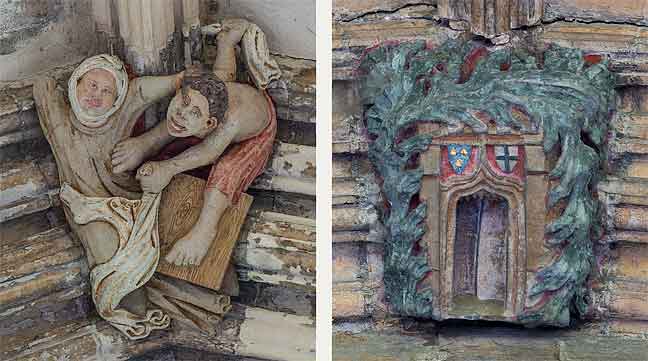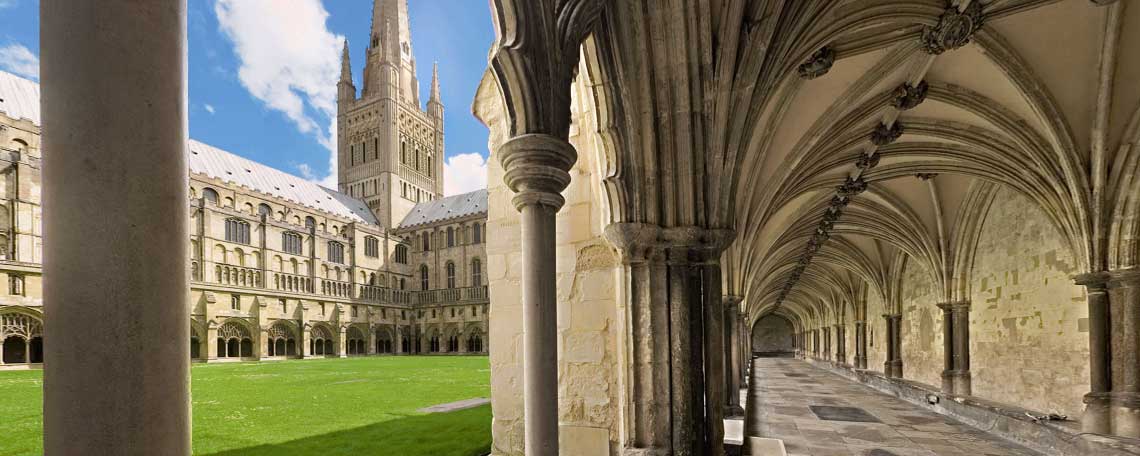The stone ledge beneath these cupboards has been worn down and polished smooth by the feet of generations of monks as they stepped up to retrieve their books upon entering the Cathedral.
Norwich Cathedral has the largest monastic cloister in England. It was constructed as a covered walkway enclosing an open quadrangle, or garth, and connected the Cathedral with the various monastic buildings. To the north the cloister is bounded by the Cathedral nave, into which there are two doors, one from each of the cloister's northern corners. To the east was the Chapter House, long since demolished, the entrance to which now leads out into the Cathedral Close. A doorway, now bricked up, led to the stairs to the monks' dormitory above. On the south side were the refectory and the infirmary. Nothing remains of the latter, but a stunning new Refectory, opened in 2004 and combining medieval and modern architecture, now stands on the site of the former. Open seven days a week it serves refreshments and light lunches, and is well worth a visit. From the west walk a door led into the priory's guest hall, or hostry, and now leads into the new Hostry building, partly funded by the Heritage Lottery Fund and completed in 2009.
The original Norman cloister was mostly destroyed during the riot of 1272, which was the culmination of a period of unrest over what the townspeople perceived as the unfair granting of landholding rights to the priory. Some of the land involved fell outside the Cathedral precincts, yet citizens living within these areas were expected to pay taxes and tithes to the priory. By the summer of 1272 things had come to a head and a state of siege existed. Efforts to reach a peaceful settlement failed when the Prior brought in armed mercenaries from Yarmouth who arrived by boat directly into the Cathedral precincts. They subsequently sallied forth into Norwich at night, burning and looting as they went. Several citizens were wounded and one was killed. The next day the city authorities called for a muster of men, and a raid on the priory ensued, and it is said that flaming arrows were fired from the nearby tower of the church of St George Tombland. One of the Cathedral gates was burned down to gain access, and several buildings within the precinct, including the church of St Ethelbert and the priory's bell tower, were ransacked and burned. Most of the monastic buildings, including the cloister, were destroyed and the fire spread to the Cathedral itself. Evidence of this can still be seen inside the Cathedral in places where the stonework has taken on a pinkish discolouration caused by the extreme heat.
The dispute was finally settled through arbitration by the king, Edward I, and rebuilding of the cloister commenced in 1297. Progress was slow and sporadic, however, and the work was not completed until 1430. The most prolonged period of inactivity was caused by the arrival in 1349 of the Black Death, to which it is thought that more than one quarter of the city's population succumbed. Evidence of this pause is visible today and is marked by a sudden change in the design of the stone tracery of the open window arcades. Those completed before the interruption are in the Decorated style, but by the time work resumed the new Perpendicular style was in vogue.
Norwich Cathedral has over one thousand roof bosses, more than any other church or cathedral in the world. These are the elaborately carved and painted undersides of the keystones essential to the construction of a vaulted roof and placed at the intersection of its ribs. What is unique to those in Norwich Cathedral is that many illustrate a series of stories from the Bible. The oldest are those in the cloister, placed in position during the rebuilding following the riot. The earliest of these, on the east walk, have foliage as their motif and include a ‘green man’ peering out from behind a mask of leaves. The later ones show scenes from the Passion of Christ and the Apocalypse. Those in the Cathedral nave are more recent, placed when the original wooden roof was replaced with stone vaulting in the fifteenth century, and tell the history of the world, from the Creation to Doomsday.
Norwich Cathedral and The Close have been used as locations for a number of films, of which the latest is Tulip Fever, an adaptation of the historical novel by Deborah Moggach. For this the cloister garth was transformed into the grounds of an orphanage in Holland in the 1630s, during the period of ‘tulip mania’ when fortunes were made and lost trading in tulip bulbs.
All images on this page appear by kind permission of the Dean and Chapter of Norwich Cathedral. For much more information about Norwich Cathedral click here to visit the Cathedral website.

A section of the stone carving above the Prior's Door, from c.1310.

The stone ledge beneath these cupboards has been worn down and polished smooth by the feet of generations of monks as they stepped up to retrieve their books upon entering the Cathedral.

Two of the roof bosses in the Cloister.
Left: A thief caught stealing the washing.
Right: An open door, over the entrance to the hostry, symbolising welcome and hospitality.
© 2022 Norwich360
All Rights Reserved



